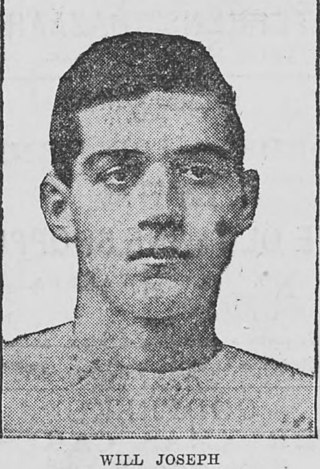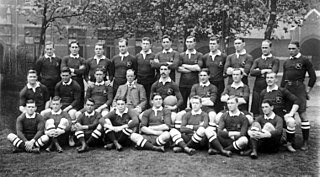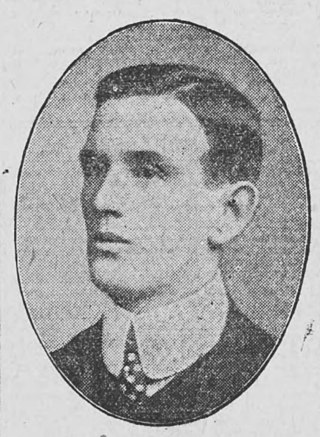
Paul Johannes Roos was one of the first South African Springbok rugby union captains and led the first South African rugby team to tour overseas – to Britain in 1906. Roos was born near the South African town of Stellenbosch on 30 October 1880 and completed his education there.
Edgar Long was a Welsh international rugby union flanker who played club rugby for Swansea and was capped seven times for Wales. He is best remembered not for his international duties, but for his marshalling of the Swansea pack during the club's victory of the 1935 touring New Zealand team.

Will Joseph was a Welsh international rugby union player. He was a member of the winning Welsh team who beat the 1905 touring All Blacks. He played club rugby for Swansea and county rugby for Glamorgan.

The 1906–07 South Africa tour of Europe was a collection of friendly rugby union games undertaken by the South Africa national team against the four British Home Nation teams. The tour also took in several matches against British and Irish club, county and invitational teams before finally travelling to France to play the national team.
| repyears1 = | repyears2 = 1953–1961 | repyears3 = 1959 | repcaps1 = | repcaps2 = 21 | repcaps3 = 2 | reppoints1 = | reppoints2 = 50 | reppoints3 = 5 | ru_ntupdate = | coachteams1 = | coachyears1 = | ru_coachupdate = | occupation = timber-merchant | relatives = Len Davies (brother) }}
Fred Birt was a Welsh international, rugby union centre who played club rugby for Newport and county rugby with Monmouthshire. He won seven caps for Wales but is most notable for his outstanding performance against the 1912 touring South African team for Newport. He was also a member of the Wales bowls team.

William Purdon Geen was a rugby union wing and centre, who represented Wales, and played club rugby for Oxford University and Newport and county rugby for Monmouthshire. He was also invited to play for the Barbarians on several occasions. Geen unsuccessfully trialled for England in 1910, but was selected and played for Wales on three occasions in the 1912–1913 season. Injury prevented him from playing more internationals, and his service in the First World War put an end to his career.
William Davies, known more commonly as "Sgili", was a Wales international rugby union player who played club rugby for Swansea. He won four caps for Wales and was part of the Welsh side that faced the touring South Africans in 1931.
Jim Lang was a Welsh international rugby union number 8 who played club rugby for Llanelli and Swansea. Whilst with Llanelli he faced two touring Southern Hemisphere teams, the South Africans in 1931 and New Zealand in 1935.
Not to be confused with American lawyer and public official Horace Holmes Thomas
Howell Lewis was a Welsh international rugby union wing who played club rugby for Swansea Rugby Football Club and was capped for Wales on four occasions. Lewis was also part of the Swansea team that beat the touring South Africa team in 1912.

William Hunter Towers was an English-born rugby union forward who played club rugby for Swansea and county rugby for Durham. He was capped twice for Wales and was part of the Welsh team that faced the first overseas tourists, the New Zealand Natives.
Tom Morgan was a Welsh international rugby union centre who played club rugby for Llanelli and international rugby for Wales. Morgan was a collier by profession.
Daniel Griffiths was a Welsh international rugby union forward who played club rugby for Llanelli and international rugby for Wales. Morgan was a collier by profession.
David John Thomas was a Welsh international forward who played club rugby for Swansea Rugby Club. He won ten caps for Wales and is most notable for scoring the only try in Swansea's win over South Africa in 1912.

Lieutenant Hopkin "Hop" Thomas Maddock MC was a Welsh international rugby union wing who played club rugby for Pontycymer and London Welsh and county rugby for both Glamorgan and Middlesex. Maddock played in six international rugby games for Wales scoring a total of six tries. A pacey and elusive runner, Maddock set several scoring records at London Welsh, and scored 170 tries during his career with the club.

John "Jack" Anderson Powell was a Welsh international rugby union forward who played club rugby for Cardiff and London Welsh. Powell played a single international game for Wales, in 1906, and faced the Original All Blacks as part of the Glamorgan county team in 1905 and the South African team as a member of the Cardiff team in 1907.
Glamorgan County RFC is a Welsh rugby union club that manages an invitational team, known as Glamorgan that originally played rugby at county level. The team is made up of amateur players from sports clubs in the Glamorgan region and historically played matches against other county teams from Wales and England, and during the 20th century was a key fixture for touring international teams. Today the club manages Glamorgan's premier rugby union tournament, the Glamorgan County Silver Ball Trophy, and arranges invitational Glamorgan teams to face Welsh rugby clubs during celebrations, such as anniversaries.
John Charles Meredith Dyke was a former Wales international rugby union fullback. Dyke made his debut for Wales on 1 December 1906 versus South Africa and was selected for the 1908 British Lions tour to New Zealand and Australia. He played club rugby for Penarth and London Welsh.

John "Jack" Alf Brown, colloquially known as John Alf or "Big John", was a Welsh international rugby union forward player who played club rugby for Cardiff and county rugby for Glamorgan. Brown was capped seven times for Wales and although he missed facing the first touring South African team in 1906 with Wales, he faced the tourist with both Cardiff and Glamorgan.







